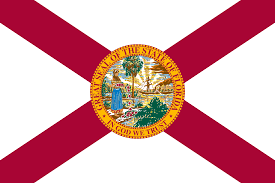Florida flag Colors Code hex, png svg
History of the Florida Flag
The flag of Florida has undergone several changes since its inception. Here’s a brief overview of its history:
- First Flags (Colonial Era)
- During the colonial period, Florida was under Spanish, French, and British rule at different times. Each of these colonial powers flew their respective national flags over the territory.
- Statehood and Early Designs (1845-1900)
- Florida became a U.S. state on March 3, 1845. Initially, the state did not have an official flag. However, unofficial flags were used during this period, including during the Civil War when Florida seceded and joined the Confederacy.
- 1900 Design
- In 1900, Governor Francis P. Fleming suggested adding a red cross of St. Andrew to the state flag to ensure it would not resemble a white flag of truce when hanging limp.
- Current Flag (1985-Present)
- The current design of the Florida flag was adopted on November 6, 1900, but it was modified slightly in 1985. The flag consists of a red saltire (diagonal cross) on a white field, with the state seal superimposed in the center.
Colors and Their Meanings
- White Background
- The white background represents purity and the desire for peace.
- Red Saltire
- The red saltire (St. Andrew’s Cross) was added to commemorate Florida’s Southern heritage and to distinguish the flag from a flag of truce. It also reflects the influence of the Confederate battle flag.
- State Seal
- The state seal includes several elements:
- Native American Seminole Woman: Represents the rich heritage of Native American cultures in Florida.
- Sunshine and Palm Trees: Symbolize Florida’s nickname, “The Sunshine State,” and its tropical environment.
- Steamboat on Water: Reflects Florida’s rivers and the importance of maritime trade and travel.
- Sabal Palmetto Palm (State Tree): Indicates the lush vegetation and natural resources of the state.
- Motto “In God We Trust”: Reflects the values and beliefs of the people of Florida.
The flag of Florida symbolizes the state’s history, cultural heritage, and natural beauty, making it a meaningful emblem for Floridians.
Guess the Flags Quiz
Sharing is caring 🤗

National Symbols 👇
- 🏁 National Flags
- 🦁 National Animals
- 🐦 National Birds
- 🌻 National Flowers
- 🌴 National Trees
- 🥭 National Fruits
- 🍹 National Drinks
- 👴 National Founders
- ☘️ National Emblems
- 🍲 National Dishes
- 🏛️ National Monuments
- ✍️ National Poets
- 🕌 National Mausoleums
- 🎺 National Instruments
- 🦸 National Heroes
- 📆 National Days

